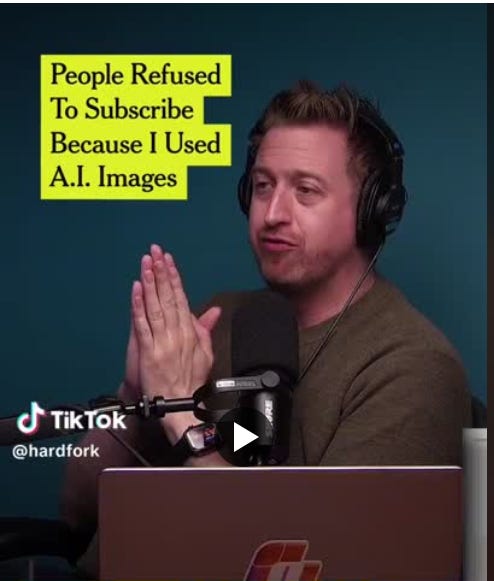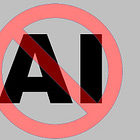Inconvenient Principles: No (unfairly trained) AI images 🗣️
🗣️ Why I don’t use generative AI for creating images (or audio, video, ...) for my publications and other work, and what has to happen before I will. (audio; 10:14)
I went on the record recently about why I don’t use generative AI for helping me write, and why I don’t ever expect to change that position. This post is about why I don’t currently use generative AI for non-written content to complement my writing (e.g. images, audio, video, …), and how & why that could change in future.
The Trigger
Late Wednesday night, I saw a post on LinkedIn by Axel Coustere about Casey Newton’s experience with pushback from potential subscribers about his use of generative AI for images (video):
Casey’s success with Platformer is impressive, and I certainly appreciate that people can have genuine intentions with using genAI tools to generate artwork for a newsletter (his has moved off Substack, unfortunately). I’m definitely not an artist myself, either, and I’ve found that it takes a lot of my ‘writing’ time to find suitable affordable/free images for my newsletter posts (since I’m operating on a shoestring at present, while getting started here on Substack).
👎 However, I align with the people who shared feedback with him that they refused to subscribe to a publication using AI-generated imagery, based on objections that the tools that don’t respect artists’ copyright and ownership.
If I can avoid it (and it’s likely a bigger IF than even I realize), I will not be a willing participant, even if indirectly, in an exploitative genAI tool ecosystem.
And at this point, the vast majority of genAI tools aren’t using ethically sourced images or content for training their models - i.e., they are exploitative.
Being a Non-Participant
By ‘participant’ in a genAI tool ecosystem, I mean:
being a tool user,
working for/with a tool provider developing the tool, or
engaging or even paying for content from someone who used the tool.
All of these are choices I can control & can make, provided there’s transparency - about whether a genAI tool is used to create content, whether the tool used is “fairly trained”, etc. - in short, transparency about whether the content was generated ethically or exploitatively.
I’d also rather not be a participant as a contributor whose work or characteristics are exploited against their will. Even though I don’t think of myself an artist, I certainly don’t want my photographs, writing, speaking or singing voice, appearance, etc. to be stolen and used without my consent. (Others may feel differently about their work and characteristics; that’s their prerogative.)
Unfortunately, in our present ecosystem, whether or not my work or personal characteristics get scraped or stolen (and then exploited) is not a choice I as a mere individual get to make. That’s sad. 😞 So I am focusing on choices I can control.
My Reasons Why
Three principles underpin my refusal to engage with exploitative genAI tools:
1. Golden Rule: Since I wouldn’t want MY creations and personal characteristics to be exploited this way, how could I possibly (ethically) justify being complicit in the exploitation of others? (i.e., by using these tools, helping to develop them, or supporting creators who use them)
2. “Pro-choice” view: Even if I were ok with MY work being ripped off without consent or compensation (and I’m not), I still would have no right to make that choice for others. Only THEY should decide about use of THEIR work. (This pro-choice view was advocated in our Part 2 article on ethics of generative AI for music.) As a believer in pro-choice, ethical behavior requires me not to directly or indirectly encourage toolmakers to deprive people of that choice (i.e. I should not use, support, or help build tools that deprive them).
3. Legal vs Ethical: Laws vary worldwide and over time, and some people might say that this type of theft and exploitation isn’t illegal in their region. However:
In our global economy, it’s highly likely that content scraped and used to train genAI models came from regions other than our own. If some of the base creative works used in training the model and building the tool were stolen from people in other regions with different laws, the fact that it’s legal to steal in your region is irrelevant.
I don’t actually care if it’s legal. Even if it’s legal to scrape and exploit, my moral compass tells me it’s still unethical. Unethical behavior shouldn’t have to also be illegal for me to not do it.
Is it inconvenient to not use cool new tools to create images to enhance my work and save me time? Oh, absolutely. It costs me hours, and even then I don’t always find great free images that fit my needs well. But “Principles only mean something when you stick to them when it’s inconvenient.” (Laine Hanson, “The Contender”). And these are my principles.
Current State
To me, living with integrity requires me to stick to these principles despite the cost. I’m resigned to the inconvenience of continuing to either use my own works or spend the time to find verifiably free/public domain works. In the meantime, I’ll carry on with my quest to find fairly trained genAI tools that I can feel good about using. (Findings will be published on along with our other deep dives on AI.)
And although I might miss detecting some, I do intend to try to avoid or minimize supporting people, publications, companies, etc. who develop unfairly trained tools or who generate content with unfairly trained tools. This is where transparency (covered in more depth here in Part 2) would come in super handy.
As I advocated last week, I believe every content creator should have an AI usage policy (that page is my AI usage policy, plus explanations on why). An AI usage policy can be simple: just say what you do/don’t do with AI, and do/don’t do what you say you will/won’t! Then link or embed the policy on an About page, or Ethics page (for those who have one), or in one’s bio.
If you’re hesitant to post an AI usage policy publicly, please consider:
If you’re not ashamed of using (possibly unfairly trained) AI tools, why would you not be transparent about it?
If you are ashamed, shouldn’t that shame be a trigger for reconsidering using the tools, or choosing different (ethically developed) tools?
Please comment or DM me if chatting would be of help!
Looking Ahead
So what would have to happen for me to switch to being an active & willing genAI tool participant in future?
Ultimately, I’m looking forward to the day when all:
Artists and content creators can freely choose how, when, and where their works are used to train genAI tools, and are compensated appropriately
GenAI tool providers are transparent about the source of their training data and whether their tools are Fairly Trained; provide traceability; support consent and compensation for content creators; and enable tool users to give informed consent when they choose to use the tool
Sites and content producers post clear AI usage policies and transparently label their works that have AI-generated content
I realize I might not live to see that day, or it may never come - but a girl can dream. And my experience is that changing it all starts with awareness.
“I did then what I knew how to do. Now that I know better, I do better.”
(Maya Angelou)
I’ve learned a lot about this whole aspect of ethics in the past 12-18 months. I’m more aware and can now ask better questions about ethical sourcing of the underlying training data. And I’ve gotten to know many people who are doing their best, and trying to know better, and helping others to know and do better. That’s how we’ll get there: by learning and caring and helping each other.
“Unless someone like you cares a whole awful lot, nothing is going to get better. It's not.” (Dr. Seuss, The Lorax)
It’s great that Casey took the feedback from potential Platformer subscribers seriously. I commend them all collectively for caring and speaking up about use of unfair AI tools! This is how things change.
I do hope to live long enough to at least see meaningful progress on all 3 of these goals, and a healthy ecosystem that includes at least a few ethical genAI tools for each artifact type (including multi-modal tools). I’ll eagerly jump to try out the fairly trained genAI tools I do find (hoping this will happen sooner than later)!
🔎 And now, I’m off to find a suitable public domain or royalty-free image to use for this post …
Update 2024-06-20: Check out
’s cool new “created with HUMAN INTELLIGENCE” images! Here’s an example:
Related pages and posts:
“AI Without AI” (my AI Usage Policy on not using LLMs for my writing)
Thanks for reading Agile Analytics and Beyond! I’d love to hear if you found this article useful. (Shares, hearts, comments, & restacks are awesome 😊, and one-time tips or voluntary donations via paid subscription are welcome & appreciated!)








![[INTRO] Unfair use? The ethics of generative AI for music 🗣️](https://substackcdn.com/image/fetch/$s_!MIIn!,w_140,h_140,c_fill,f_auto,q_auto:good,fl_progressive:steep,g_auto/https%3A%2F%2Fsubstack-post-media.s3.amazonaws.com%2Fpublic%2Fimages%2F163f723a-f4fc-4701-84a8-3a81cad85775_4896x3264.jpeg)
![WHY & FOR WHOM: Ethics of generative AI for music [Unfair use? series, PART 1]](https://substackcdn.com/image/fetch/$s_!r9QG!,w_140,h_140,c_fill,f_auto,q_auto:good,fl_progressive:steep,g_auto/https%3A%2F%2Fsubstack-post-media.s3.amazonaws.com%2Fpublic%2Fimages%2Fc06537a2-b301-4907-8b78-0aefdbdf57cf_1001x902.png)
![Ethical Risks & Challenges in GenAI music [Unfair use? series, PART 2]](https://substackcdn.com/image/fetch/$s_!X6DR!,w_140,h_140,c_fill,f_auto,q_auto:good,fl_progressive:steep,g_auto/https%3A%2F%2Fsubstack-post-media.s3.amazonaws.com%2Fpublic%2Fimages%2Ff43d4635-1899-4964-b093-ced7dda4c29e_1600x1066.jpeg)

Finding suitable images for an article or blog post has always been a pain in the behind. Before AI came along, the (ethical) choices were: (1) use Creative Commons licensed images from Flickr or Google Image Search. (2) Use free stock photography. (3) Pay for stock photography. (4) Grab your camera and take your own photo. I have used all four options extensively.
The siren song of AI-generated images is strong, but the point about unfair use is extremely compelling. I would love to be able to have a source of 'ethical; AI imagery from models that were trained exclusively on non-copyrighted or "creative-commons"- type material.
Good summary, Quentin. I’ve mostly been using Wikimedia Commons, Unsplash, and Pexels lately, plus a few of my own.
I’ve heard people recommend Adobe Firefly as one possible ethical source. Their site https://www.adobe.com/products/firefly.html claims “Trained on Adobe Stock images, openly licensed content, and public domain content, Firefly is designed to be safe for commercial use.” They also say they are compensating Adobe Stock creatives whose images get used. Likely not free after beta ends, but the fee might scale if their images can fill many needs.